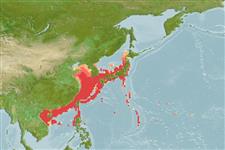Common names from other countries
Environment: milieu / climate zone / depth range / distribution range
นิเวศวิทยา
เกี่ยวกับทะเล,น้ำเค็ม; น้ำจืด; กร่อย สัตว์น้ำหน้าดิน; ปลาที่อพยพจากแหล่งน้ำจืดไปวางไข่ในน้ำเค็ม (Ref. 51243); ระดับความลึก 1 - 400 m (Ref. 6898). Subtropical; 4°C - 27°C (Ref. 12468); 46°N - 15°N, 105°E - 170°E
Asia: Japan to the East China Sea, Taiwan, Korea, China and northern Philippines. Spawning grounds of this species are presumed to be in the western Mariana Islands, at a salinity front near 15°N and 140°E (Ref. 54488). Most expensive food fish in Japan. Introduced elsewhere.
ขนาด / น้ำหนัก / Age
Maturity: Lm ? range ? - ? cm
Max length : 150 cm TL เพศผู้/กระเทย; (Ref. 9828); common length : 40.0 cm SL เพศผู้/กระเทย; (Ref. 35840); น้ำหนักสูงสุดที่มีการรายงาน: 1.9 kg (Ref. 82795)
สัตว์มีกระดูกสันหลัง: 114 - 118. Plain-colored.
Spawning occurs in the sea; small eels ascend the rivers in schools; develop and grow in freshwater. The species may crawl over land at night from one place to another (Ref. 5258, 11230). Adults feed on crustaceans, insects and fish (Ref. 5258). Maximum weight given (1889 g) has a maximum length of 100.8 cm TL in Ref. 82795. Utilized fresh, smoked, canned and frozen; eaten steamed, broiled and baked (Ref. 9988). Used in Chinese medicine (Ref. 12166).
Life cycle and mating behavior
Maturities | การสืบพันธุ์ | Spawnings | Egg(s) | Fecundities | ตัวอ่อน
Assuming reproductive mode to be the same as that of Anguilla anguilla.
Masuda, H., K. Amaoka, C. Araga, T. Uyeno and T. Yoshino, 1984. The fishes of the Japanese Archipelago. Vol. 1. Tokai University Press, Tokyo, Japan. 437 p. (text). (Ref. 559)
IUCN Red List Status (Ref. 130435)
CITES (Ref. 128078)
Not Evaluated
Threat to humans
Harmless
Human uses
การประมง: เน้นการพาณิชย์; การเพาะเลี้ยงสัตว์น้ำ: การค้า
เครื่องมือ
Special reports
Download XML
แหล่งที่มาจากอินเตอร์เน็ต
Estimates based on models
Preferred temperature (Ref.
115969): 2.5 - 23.3, mean 17 (based on 432 cells).
Phylogenetic diversity index (Ref.
82804): PD
50 = 0.5000 [Uniqueness, from 0.5 = low to 2.0 = high].
Bayesian length-weight: a=0.00062 (0.00039 - 0.00099), b=3.18 (3.05 - 3.31), in cm Total Length, based on LWR estimates for this species & Genus-body shape (Ref.
93245).
ระดับชั้นอาหาร (Ref.
69278): 3.6 ±0.51 se; based on food items.
ความสามารถในการกลับคืนสู่ปกติ (Ref.
120179): ต่ำ, เวลาต่ำสุดที่จะทำให้ประชากรเพิ่มขึ้นเป็น 2 เท่าใช้เวลา 4.5 - 14 ปี (K=0.07).
Fishing Vulnerability (Ref.
59153): High to very high vulnerability (71 of 100).
